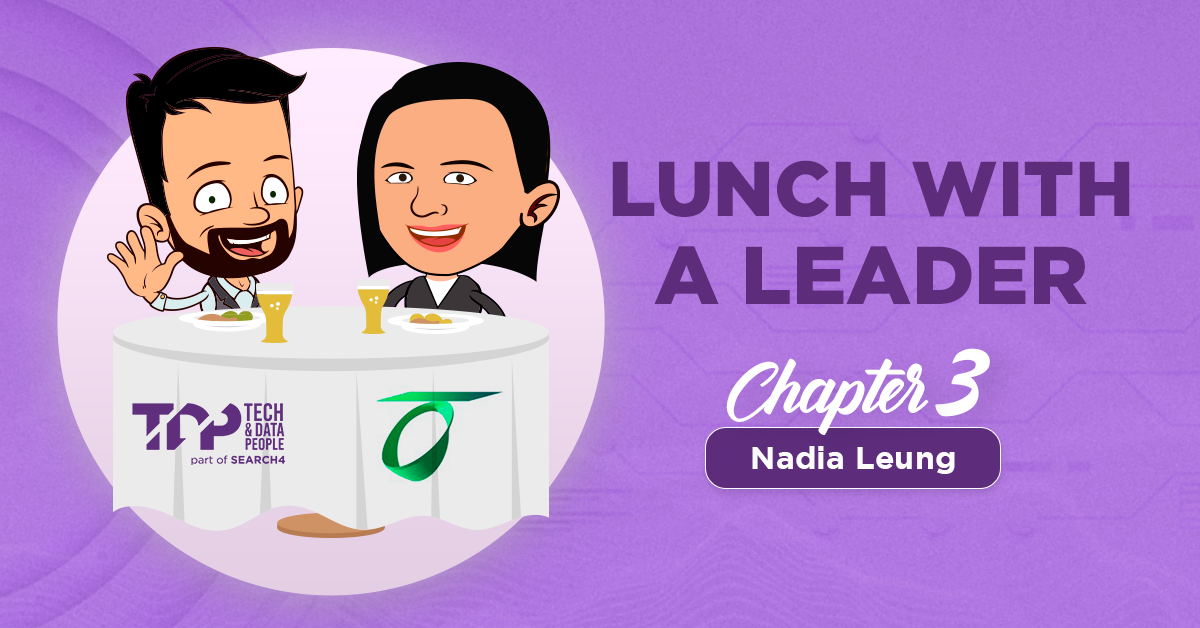Blogs
Lunch With a Leader: Chapter 3 – Nadia Leung

Welcome to Lunch with a Leader, where the Tech & Data People team sits down with IT leaders to uncover their career insights, challenges, and industry perspectives. Each conversation brings valuable lessons, trends, and advice to help our community grow and thrive.
Grab a seat at the table and take in the insights from some of the best in the business.
Nothing about IT project delivery is static, and that’s exactly why leaders like Nadia Leung – Managing Director of Tech on Track - are in such high demand. With clients pushing for faster outcomes, leaner solutions, and measurable value, she’s built a consultancy that thrives on agility, real-time visibility, and deep stakeholder alignment.
In this chapter, she shares how Tech on Track adapts to rapidly changing methodologies, why mindset still trumps tools, and how being accountable to your own brand name changes everything about the way you deliver.
Navigating Project Delivery in a Shifting Landscape
1. How does Tech on Track adapt to the rapid changes in IT delivery methodologies and client demands in project management? What do you have in place to keep up and adapt as things evolve?
Great question! AI has the potential to seriously shake up project delivery. Think better predictions, smarter schedules, and easier risk management.
But in Australia, it's still a bit of a mixed bag. While the tools are definitely out there, not everyone is jumping in. Many mid-sized businesses just don't have the resources to invest in AI at this stage - it's really the larger organisations who are leading the charge and seeing the benefits. Even when the tech is available, there’s still a skills gap. There just aren’t enough professionals with the expertise to implement and get the most out of AI tools in delivery environments.
So, in the meantime, many companies are turning to practical workarounds — tools like Monday.com and Zoho Projects are popular choices for managing schedules, risks, and issue tracking without the overhead of complex AI integrations.
We're also seeing a shift away from purist Agile. The reality is, full-scale Agile delivery just doesn’t fit every business. Smaller and mid-sized companies often aren’t structured or trained to adopt Agile in its strictest form — even if their delivery partners are Agile-certified, their clients often aren’t.
At the same time, clients are under pressure to deliver faster results and get more value for their investment. That’s where Tech on Track comes in — we offer flexible delivery models where clients only pay for the support they actually need, rather than locking in a full-time Project Manager they might not use.
2. How do you juggle delivering quick project wins while still keeping an eye on the bigger picture when it comes to IT strategy and infrastructure?
How I usually prioritise projects is by splitting them into two main buckets:
- Quick wins
- Long-term strategic initiatives
Quick wins give us fast outcomes, while the strategic projects focus on bigger-picture innovation. That balance helps make sure we’re not just ticking boxes in the short term but also building towards something more sustainable.
Agile really supports this approach. It’s designed to speed up time to value, while still giving us room to adapt and scale. Whether it’s two- or three-week sprints, the aim is always to deliver meaningful progress early.
It also gives clients a seat at the table when priorities shift. You might start with one focus, then a few weeks in, something changes. Agile gives us the flexibility to pivot without losing momentum.
3. With Tech on Track handling some pretty complex IT projects, how do you keep communication flowing smoothly and collaboration between different teams and departments, especially when you've got a mix of technical specialists working together?
When I start working with a new client, one of the first things I do is set up a clear communication plan. It’s about making sure everyone’s aligned on how we’ll work together — how often we meet, how reporting will work, and who to go to if something comes up.
I also make a point of connecting early with senior leaders across departments. Everyone has different priorities and preferences, even within the same organisation, so it’s important to understand what they care about and how often they want updates.
Having that broader view of organisational goals is key when managing complex projects. One thing we always focus on to keep things running smoothly is how we provide updates. We're always looking at tech to help us give those updates in real-time.
On a recent engagement, I implemented a project management tool that gave stakeholders real-time visibility across all active projects. Senior leaders could log in anytime to view a dashboard with the latest status updates, while project managers refreshed their reports every couple of weeks. Tools like Jira and Confluence are great for this — they allow us to centralise reporting so execs don’t have to sit through every meeting to stay in the loop.
More and more, we’re seeing that real-time reporting is crucial and expected. Everyone’s busy, and not everyone can make every meeting, so giving people on-demand access to the info they need has become a non-negotiable for project success.
4. How do you show clients the real impact of Tech on Track’s work? What are the key metrics you use to demonstrate the value you’ve delivered?
We track several key metrics, tailored for each organisation and project, including:
- Project governance compliance (adherence to the framework)
- Risk management effectiveness (number of risks mitigated)
- Change control efficiency (timeliness of addressing change requests)
- Team collaboration score (gauged via surveys)
- Decision turnaround time.
We offer clients a selection of these metrics to align with their specific needs and translate project management concepts into their terminology.
5. Strong project delivery depends on collaboration. How do you build a culture of cross-functional teamwork, both within Tech on Track and when working with client teams, to keep projects on track and successful?
What really drives project success is knowledge-sharing and learning from past experiences. It's way more important than just being a tech whiz. A lot of organisations focus on hiring project managers with specific tool experience, like SAP or Microsoft Dynamics. But in reality, a great project manager knows how to apply lessons learned across different environments.
Where projects often come unstuck is culture and structure. Every company is unique, whether it has a formal PMO, an IT governance model, or something more ad hoc. It’s these internal dynamics, more than the technology itself, that tend to trip up delivery.
Projects usually fail because of fuzzy processes, unclear roles, or inconsistent ways of gathering requirements. If the people responsible for defining requirements aren’t equipped or supported to do it well, things can go off track before the build even starts. In the end, many delivery issues trace back to how the project was set up from day one.
6. What advice would you give to someone who wants to take the leap and start their own consultancy?
It's seriously tough work. There's so much that goes on behind the scenes. I've been fortunate to leverage my talented network and have worked with innovative organisations like Accenture and Ericsson.
That said, I think more people should consider starting their own consultancies as there's a real need for it. When it's your name on the line, you work differently. For me, Tech on Track is my brand and I can't afford to have a project fail.
As a delivery professional, I'll work day and night to make sure it's a success. That's what clients are paying for. It's a different mindset. You bend over backwards, go the extra mile, and when it all pays off, it’s incredibly rewarding to make a project a success. There’s nothing quite like finishing a project and getting that positive feedback, it makes it all worth it.

State Lead, VIC











